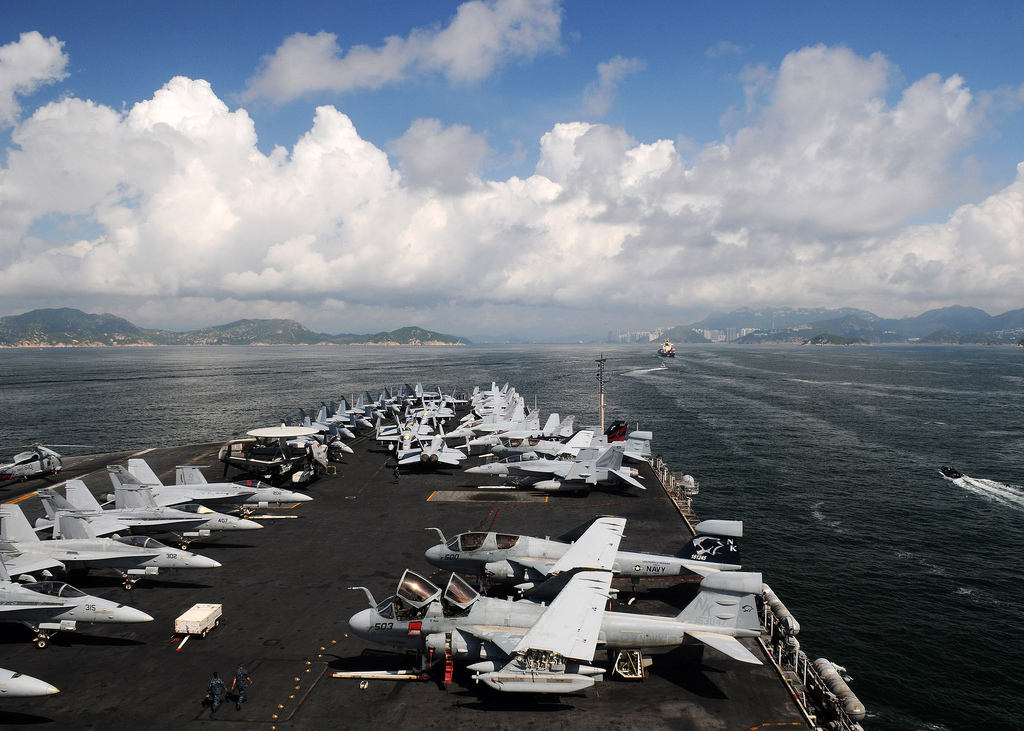In late October 2015, the guided missile destroyer USS Lassen (DDG-82) supported by a P-3 Orion and a P-8 Poseidon maritime surveillance aircraft, launched a freedom of navigation operation (FONOP) in the South China Sea. This operation brought a US military formation within the 12-mile boundary of one of China’s reclaimed coral atolls for the first time, in this case, Subi Reef.
The development of 3,000 metre-long air strips on several of these reclaimed islands has led to questions being asked as to whether China will declare an Air Defence Identification Zone (ADIZ) over the South China Sea. According to recent reports, Beijing has deployed fourth-generation J-11 fighter aircraft from Hainan Island to Woody Island in the Spratly Island chain. This, combined with the rhetoric emanating from President Xi Jinping, who continues to press China’s historic claims in state-run media, makes this question all the more pertinent.
Tensions in the East China Sea
With the world’s attention focused heavily on the South China Sea, Asia’s other major maritime dispute in the East China Sea continues to simmer between neighbours Japan and China. In July 2015, Japan’s Ministry of Defence released over a dozen photographs of 16 Chinese oil and gas platforms operating within the East China Sea and close to the disputed maritime boundaries.
While China continues to demonstrate a willingness to assert itself in the East China Sea, these actions have come at a cost to Beijing’s interests: in the short term, pushing concessions from Japan over the Senkaku/Diaoyu islands, and in the long term, weakening the US-Japan security alliance, which China considers a ‘Cold War relic’.
The establishment of the East China Sea Air Defence Identification Zone (ADIZ), which was declared by Beijing in November 2013, has failed dramatically to influence Tokyo’s position on the Senkaku Islands. Instead, the East China Sea dispute has formed the backdrop for major domestic security reforms undertaken by the Shinzo Abe administration. Amid the backdrop of regular intercepts by the JSDF of Chinese and also Russian aircraft, Prime Minister Abe has successfully pushed through defence reforms in September 2015, to allow Japan to engage in acts of “collective self-defence” alongside the United States.
A more militarily proactive Japan in the Asia-Pacific can hardly be qualified as a boon to China’s regional ambitions and foreign policy aims.
Likewise, China’s assertiveness towards Japan has proven detrimental to Beijing’s goals of weaker and looser ties between Washington and Tokyo. In the last year the Senkaku/Diaoyu dispute has seen President Obama forcibly reaffirm the US-Japan defence alliance, pushing Washington to announce that an alteration of the status quo in the Senkaku islands would invoke the defence pact. In light of the annexation of Crimea and Russian moves into Ukraine, the declaration of a Chinese ADIZ over Japanese territory forced the Obama administration to declare unequivocally that any alterations of the current status of the Senkaku/Diaoyu dispute would bring in the US 7th Fleet.
After two years of intense aerial activity by China, alongside a sustained campaign of anti-Japanese rhetoric in state run media, the ADIZ in the East China Sea has not produced any measureable level of success for Beijing.
A test of wills in the South China Sea
Initially, the East China Sea was largely seen as an isolated area of tensions, based on the historical rivalry and memories of World War II that still inform Sino-Japanese relations. However, given the increased level of Chinese activity in the South China Sea since December 2013, there are concerns that precedents set in the contested waters near Japan may also be applied to the South East Asian maritime sphere.
The disputed waters of the East and South China Sea are increasingly becoming the principal arena in Asia for a test of wills by the armed forces of the United States and China. In the days prior to the USS Lassen (DDG-68)’s conducting its FONOP patrol, news emerged that a Chinese Song class submarine had stalked the aircraft carrier USS Ronald Reagan (CVN-76) in the Sea of Japan. Meanwhile in mid-November, the United States sent two B-52 bombers from Guam into the South China Sea, where they faced repeated radio challenges from Chinese operators based on the disputed reefs. These incidents are now becoming regular occurrences, as the US and China continuously encounter each other in the air and sea.
China is a rising maritime actor who seeks to be the principal maritime claimant in the South China Sea, and is developing a blue-water navy capable of projecting power in its near abroad. Central to this is China’s development of aircraft carriers. Recent reports suggest the country has started construction of its first indigenous aircraft carrier, codenamed the Type 001A, at the Dalian Shipyard. Based on satellite photographs, the carrier is estimated to weigh between 65,000 to 70,000 tons in displacement. The carrier appears to be equipped with a ski-jump to launch aircraft similar to China’s current flagship Liaoning, and to be of a size capable of carrying a combination of J-15 strike fighters and anti-submarine warfare (ASW) helicopters.
This Type-001A is not expected to enter service until 2022; however, it still represents a far less capable platform compared to those of the United States due to the reliance on the ski-jump, which limits overall weight.
Until China can deploy multiple carrier strike groups in strength, Beijing will face a difficult clash of ‘intentions vs. capabilities’ in the South China Sea, if it seeks to implement an ADIZ in the South China Sea. As previously stated, an ADIZ is not a no-fly-zone but rather an extension of the security precautions China undertakes concerning aircraft in its territorial airspace. Such an undertaking would require a far greater exercise of military force than a handful of fighter aircraft.
While the East China Sea has the advantage of its proximity to the Chinese mainland, such geographical advantage does not exist in South East Asia. At present, Beijing simply does not have the technical means to enforce a South China Sea ADIZ with any consistent degree of military force.
In six years however, the situation may well be changed.
Consequences of an ADIZ in the South China Sea
In the context of the geopolitical failure in the East China Sea -military means aside, it is questionable whether Beijing feels an ADIZ in the South China Sea would be useful in achieving China’s interests.
China is aware that on the issue of the South China Sea, it risks being the object of an increasingly hostile consensus between littoral states, such as the Phillipines and Vietnam, one being a US-treaty ally and the other seeking greater US security guarantees.
Such is the current suspicion of Beijing’s land reclamation program, that both the Royal Australian Navy and the Japanese Maritime Self Defence Forces have talked about launching their own Freedom of Navigation operations alongside the United States. In contrast to Vietnam or the Philippines, these navies are equipped with state-of-the-art guided missile destroyers, modern amphibious assault vessels and are US treaty allies.
Their involvement in the South China Sea would be a geopolitical disaster for Beijing and would only be hastened by the declaration of an ADIZ.




